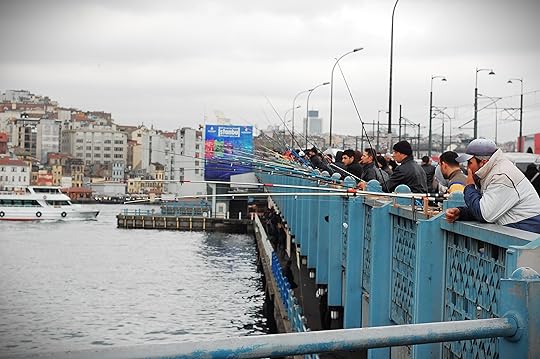Balkanesque & Asia Minoresque: In between the silvery lines of the new and the pastel shades of the old across Bursa
With the old on your mind, try and picture yourself in the early daysof the silk trade. The hustle and the dust, the inviting flavours, the richnessof scents – they are all lingering features, but can the twenty-first-centuryBursa still capture them and keep them alive?
‘The first Ottoman capital’ [back in 1326] or ‘Green Bursa’ are nicknames that may ring a bell. Whatabout the other feasts that the fourth-largest city in Turkey boasts and isready to offer its visitors?

Silk, you are already aware of it, and there’s Kozahan [silk cocoonhall, revamped into a tea garden with shops and stalls and fortune tellers toread your coffee cup], built in 1451, that will not let you forget about it.
One thing that comes into mind when talking with connoisseurs about Bursa is İskender kebap. And every single guide onBursa that you consult will let you know that this dish – roasted and slicedlamb spread atop diced pita breadpieces, topped with tomato sauce and served with yoghurt – has originated here,being named after its inventor İskender Efendi (who lived in Bursa during thelate nineteenth century) and becoming popular worldwide. However, the legendgoes that no dish tastes better than the original one in Bursa [@Kebapçıİskender].
Apart from the peaches of Bursa, allegedlyunique, there is another dessert that might tempt those with a sweet tooth: Kestane şekeri. Chestnuts boiled in vanillasugar syrup... that must surely be a treat. Here’s a reason not to leave thecity without trying at least one chestnut candy.
You can find all of these in Bursa’s KapalıÇarşı (Covered Market), much smaller than Istanbul’s Grand Bazaar and its webof 4000 shops, but still pleasant. Unquestionably, silk is a strong element ofmany shops. A special venue is Eski Aynalı Çarşı (‘The Old Mirrored Market’),initially built as a hamam, but later converted into shops, in Middle Easternfashion. These Turkish baths abound in the city and are not to be missed for avisit/soak time to remember for the rest of your life.
Are we anywhere near discussing history here?Well, in terms of architecture, Bursa’s mosques are mainly Ottoman in style(based on Byzantine and Persian models, which explains the colours used). Goodexamples to feast your eyes on are Muradiye Cami (The Mosque of Sultan MuratII, 1426) and Yeşil Cami (The Green Mosque, 1424), with a very unusual fountaininside the prayer area. Opposite the latter, you can find Yeşil Türbe, themausoleum of Mehmed I, the fifth Ottoman Sultan. However, the ancient Seljukstyle can be retraced in Ulu Cami (The Great Mosque, 1399), adorning 20 domesand 2 minarets. Another tomb worth mentioning to the explorer is Orhan GaziTürbesi, the resting place of the second Ottoman Sultan – Orhan, the son ofOsman I.
Whether you tend to have a great passion forbridges and their history or not, Irgandı Köprüsü (1442) will surprise you. Itstands as another example of Ottoman architecture. Restored, it now housesshops, handicraftsmen, and – of course – cafés.
If you wish to get out of the city and explorethe great outdoors, you are in for a pleasant surprise. Mainly because Uludağ(The Great Mountain), the Mount Olympus of the ancient province of Bithynia,northwestern Turkey’s highest peak and most acclaimed winter resort, is onlyone cable car (Teleferik) ride away from Bursa’s upper neighbourhood ofTeferrüç. To the joy of skiers, snowboarders, and hikers. Or of those in badneed of a breath of fresh air.

There is a very special place [read:‘village’] at the foot of Uludağ and it is called Cumalıkızık. Whether you ride in a dolmuş (minibus) or a car, you will still feel the bumps and wonderif you are in the right place. And then there are the villagers with freshfruit, exotic jams (make sure you try the pomegranate one out!), and evenhandmade jewellery and home decorations. The winding and narrow alleys willtake you along small orchards and very old houses, most of which are still inhabited.And then, if you are truly lucky, you might be invited by one of the villagersfor a traditional cheese gözleme andsome tea.

What about water lovers? There’s alwaysGölyazı for you. A small fishing village just outside Bursa, waiting to fillyou with tranquillity and many unforgettable sights. Old buildings, a seeminglyold way of life, and nature at one’s fingertips: these are probably Gölyazı’sstrengths, all of them focused around Lake Uluabat. If you are indeed in lovewith nature, do not forget to pay a visit to Tarihi Çınar – a 600-year-oldsycamore tree, in the Village of İnkaya. Just wonder how much it haswitnessed...
At the end of every day spent in Bursa, youshould savour a cup of Turkish coffee and think back at the moments you mostenjoyed while you envision your return. Think of the people you met and howmuch they helped you, smiled at you, and made you feel welcome. And even if youare away in Istanbul or anywhere else in Anatolia, you should always rememberthat Bursa is one ride away. Over the bumpy hills with the Turkish flag proudlyflaunting in the wind.

/The piece was first published in January 2015 on www.skylife.com– Turkish Airlines’ in-flight magazine –, which ceased to exist; not includedin social media posts and the weekly newsletter/



